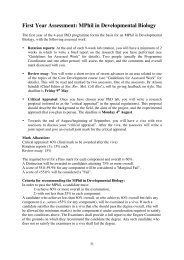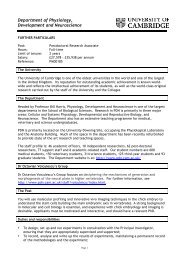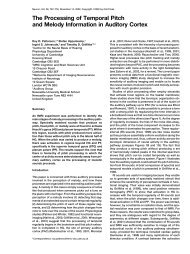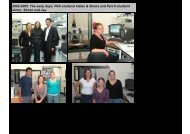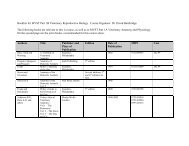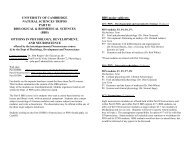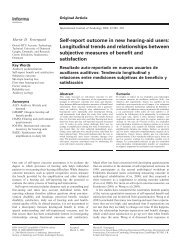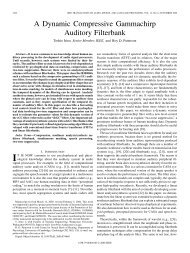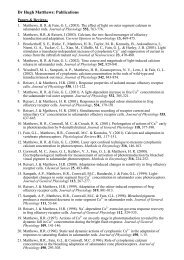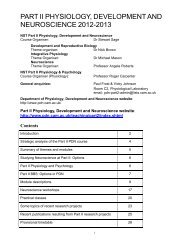FRIDAY MORNING, 20 MAY 2005 REGENCY E, 8:30 A.M. TO 12:00 ...
FRIDAY MORNING, 20 MAY 2005 REGENCY E, 8:30 A.M. TO 12:00 ...
FRIDAY MORNING, 20 MAY 2005 REGENCY E, 8:30 A.M. TO 12:00 ...
Create successful ePaper yourself
Turn your PDF publications into a flip-book with our unique Google optimized e-Paper software.
11:<strong>30</strong><br />
5aPAb5. Measurements of the rate of change of the power spectral<br />
density due to nonlinearity in one-dimensional propagation. Lauren<br />
E. Falco, Kent L. Gee, and Anthony A. Atchley Grad. Program in<br />
Acoust., Penn State Univ., 217 Appl. Sci. Bldg., University Park, PA<br />
16802-5018<br />
The influence of nonlinear effects in the propagation of jet noise is<br />
typically characterized by examining the change in the power spectral<br />
density PSD of the noise as a function of propagation distance. The rate<br />
of change of the PSD is an indicator of the importance of nonlinearity.<br />
Morfey and Howell AIAA J. 19, 986–992 1981 introduced an analysis<br />
technique that has the potential to extract this information from a measurement<br />
at a single location. They develop an ensemble-averaged Burgers<br />
equation that relates the rate of change of the PSD with distance to the<br />
quantity Q p 2 p , which is the imaginary part of the cross-spectral density of<br />
the pressure and the square of the pressure. Despite its potential applicability<br />
to jet noise analysis, the physical significance and utility of Q p 2 p<br />
have not been thoroughly studied. This work examines Q p 2 p for the onedimensional<br />
propagation of plane waves in a shock tube. The use of such<br />
a simple, controlled environment allows for a better understanding of the<br />
significance of Q p 2 p . Work supported by the National Science Foundation,<br />
the Office of Naval Research, and the Strategic Environmental Research<br />
and Development Program.<br />
11:45<br />
5aPAb6. Nonlinear standing waves in shaped resonators driven by a<br />
piston. Cheng Luo, Xiaoyang Huang, and Nam Trung Nguyen School<br />
of Mech. and Production Eng., Nanyang Technolog. Univ., 50 Nanyang<br />
Ave., Singapore 639798<br />
The nonlinear standing waves in a shaped resonator driven by a piston<br />
are investigated analytically and experimentally. In the study, the resonator<br />
is an exponentially expanded horn with a piston oscillating at its large end.<br />
The air pressure waves inside the resonator are obtained by solving a 1-D<br />
nonlinear wave equation with the Galerkins method, taking into account<br />
the moving boundary due to the piston. The simulation results, in terms of<br />
the pressure waveforms, the pressure amplitudes, and the resonance frequency<br />
shift, show that the nonlinear standing waves generated by the<br />
piston have characteristics similar to those in the same resonator but under<br />
entirely shaking condition. The experiment is also conducted on an exponentially<br />
expanded resonator. The small end of the resonator is sealed and<br />
the big end is connected to a 5-inch 40 W loudspeaker, functioned as the<br />
driving piston. The resonance frequency shift is observed, and high amplitude<br />
pressures, up to 0.310 5 Pa, have been detected at the small end,<br />
which is <strong>20</strong> times higher than that at the big end. The experimental results<br />
agree well with the simulated values.<br />
<strong>FRIDAY</strong> <strong>MORNING</strong>, <strong>20</strong> <strong>MAY</strong> <strong>20</strong>05<br />
<strong>REGENCY</strong> C, 8:<strong>00</strong> A.M. <strong>TO</strong> <strong>12</strong>:<strong>00</strong> NOON<br />
Session 5aPP<br />
Psychological and Physiological Acoustics: Auditory Perception and Psychophysics II „Poster Session…<br />
Neal F. Viemeister, Chair<br />
Dept. of Psychology, Univ. of Minnesota, 75 East River Rd., Minneapolis, MN 55455<br />
Contributed Papers<br />
All posters will be on display from 8:<strong>00</strong> a.m. to <strong>12</strong>:<strong>00</strong> noon. To allow contributors an opportunity to see other posters, contributors of<br />
odd-numbered papers will be at their posters from 8:<strong>00</strong> a.m. to 10:<strong>00</strong> a.m. and contributors of even-numbered papers will be at their<br />
posters from 10:<strong>00</strong> a.m. to <strong>12</strong>:<strong>00</strong> noon.<br />
5aPP1. Sensitivity to stimulus distribution characteristics in auditory<br />
categorization. Sarah C. Sullivan Dept. of Psych., Univ. of Texas,<br />
Austin, TX 787<strong>12</strong>-0187, Andrew J. Lotto Boys Town Natl. Res.<br />
Hospital, Omaha, NE 68131, Elizabeth T. Newlin, and Randy L. Diehl<br />
Univ. of Texas, Austin, TX 787<strong>12</strong>-0187<br />
Several experiments were performed to examine the ability of humans<br />
to categorize sounds as a function of training distribution characteristics.<br />
Participants were presented non-speech sounds randomly sampled from<br />
two overlapping distributions. The sounds consisted of 25 narrow-band<br />
noise bursts varying in center frequency from 1<strong>00</strong>0–1360 Hz. Two conditions<br />
were created by varying the ratio of stimuli in each category i.e.,<br />
prior probabilities of each category, resulting in different ideal boundaries<br />
maximizing accuracy. Participants were asked to categorize the sounds<br />
as either A or B and feedback was provided. In one experiment, prior<br />
probabilities were altered mid-session without alerting the subjects. Performance<br />
was tracked by plotting identification functions and noting<br />
boundary placement for each individual block. After only six blocks of<br />
training (35 min), most subjects had established optimal or nearoptimal<br />
boundaries. Identification function slopes were calculated and<br />
found to be steeper than training distribution slopes; suggesting that listeners<br />
established criterion-like boundaries as opposed to performing<br />
probability matching. The fact that listeners adjusted their responses in<br />
accordance to distribution changes within relatively short periods of time<br />
demonstrates the perceptual systems effectiveness at optimizing categorization<br />
based on distribution characteristics. Work supported by NSF and<br />
NIDCD.<br />
5aPP2. Hearing silent shapes: Identifying the shape of a sound<br />
occluding surface. Ryan L. Robart and Lawrence D. Rosenblum Univ.<br />
of California, Riverside, Riverside, CA, 92521, rosenblu@citrus.ucr.edu<br />
While most psychoacoustics is concerned with perception of sound<br />
sources, there is evidence that surfaces which reflect or occlude sound can<br />
also be detected and can guide behavior e.g., M. S. Gordon and L. D.<br />
Rosenblum, J. Acoust. Soc. Am. 107, 2851 <strong>20</strong><strong>00</strong>. While there is also<br />
evidence that listeners can hear the shape of sound reflecting surfaces<br />
e.g., C. E. Rice, Science 155, 655–664 1967, it is not known whether<br />
the shape of sound occluding surfaces can be heard. In a series of experiments,<br />
blindfolded listeners were asked to judge the shape of surfaces of<br />
equal area which occluded a set of loudspeakers emitting white noise.<br />
Overall, listeners were successful at this task, with some listeners showing<br />
near perfect performance. Follow-up experiments examined the acoustic<br />
information supportive of this skill. The findings suggest a type of auditory<br />
sensitivity not often considered in the psychoacoustics literature.<br />
2596 J. Acoust. Soc. Am., Vol. 117, No. 4, Pt. 2, April <strong>20</strong>05 149th Meeting: Acoustical Society of America 2596



